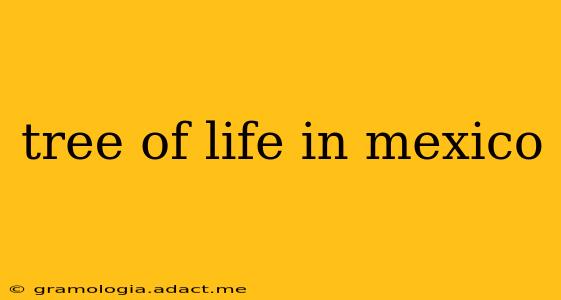Mexico, a land of vibrant culture and ancient traditions, boasts a rich tapestry of symbolism woven into its very fabric. Among the most enduring and powerful symbols is the "Árbol de la Vida" – the Tree of Life. Far from being a singular representation, the Tree of Life in Mexico takes on diverse forms, reflecting regional variations and evolving interpretations throughout history. This article explores the multifaceted nature of this iconic symbol, delving into its historical context, artistic representations, and cultural significance.
What is the Tree of Life in Mexican Culture?
The Mexican Tree of Life, or Árbol de la Vida, is a symbolic representation often depicted in folk art, particularly in ceramics. It's not a depiction of a single specific tree species, but rather a stylized representation of the interconnectedness of life, the cosmos, and the spiritual world. These intricate designs typically feature a central tree trunk laden with vibrant fruits, animals, and other elements, creating a visual narrative brimming with symbolic meaning.
What are the symbols on the Tree of Life?
The symbols adorning the Tree of Life are richly diverse and often vary depending on the artist and region. However, some common motifs include:
- Animals: Representing the abundance of wildlife, earthly creation, and sometimes specific cultural narratives or beliefs. Common animals include birds, snakes, jaguars, deer, and rabbits.
- Fruits and Vegetables: Symbolizing fertility, abundance, and the bounty of the earth. These often include native Mexican fruits like mangoes, avocados, and chilies.
- Humans: Depicting daily life, community, and the human connection to nature.
- Religious Symbols: Sometimes incorporating elements from Christianity (like crosses or angels) or pre-Hispanic religions, demonstrating the blending of cultural influences.
- Architectural Elements: Houses, churches, and other structures often appear, highlighting the human impact on the landscape and the integration of nature and civilization.
Where did the Tree of Life originate?
While the exact origins are debated, the Tree of Life's symbolism has roots in ancient Mesoamerican cultures. Pre-Hispanic societies held deep reverence for nature and often depicted trees as powerful spiritual symbols connecting the earthly and celestial realms. The modern artistic representations are a continuation of this ancient tradition, adapted and transformed over time.
What is the meaning of the Tree of Life in Mexican art?
The meaning of the Tree of Life is multifaceted and open to interpretation. However, several recurring themes emerge:
- Life, Death, and Rebirth: The cyclical nature of life is often emphasized, symbolized by the tree's continuous growth and the abundance of life surrounding it, even in the presence of decaying elements.
- Interconnectedness: The Tree of Life illustrates the intricate web of relationships between all living things, highlighting the interconnectedness of the natural world and humanity.
- Paradise: The lushness and abundance depicted often evoke a sense of paradise, a place of harmony and prosperity.
- Cultural Heritage: The incorporation of diverse symbols reflects the rich cultural heritage and traditions of Mexico, blending pre-Hispanic and colonial influences.
What is the significance of the Tree of Life in Mexican culture today?
Today, the Tree of Life continues to hold great cultural significance. It's a popular motif in folk art, souvenirs, and even contemporary artistic expressions. It serves as a powerful symbol of Mexican identity, reflecting the nation's rich history and vibrant culture. The enduring appeal of the Árbol de la Vida underscores its importance as a symbol that continues to resonate with Mexicans and fascinates those from around the world.
How is the Tree of Life used today?
Beyond its artistic representations, the Tree of Life's symbolism permeates various aspects of Mexican culture:
- Folk Art: It remains a central theme in pottery, wood carving, and other traditional crafts.
- Tourism: The Tree of Life is a popular motif in souvenirs, attracting tourists seeking to connect with Mexican culture and artistry.
- Contemporary Art: Contemporary artists continue to reinterpret and explore the symbol's meaning, creating new and innovative works.
The Mexican Tree of Life is far more than just a pretty picture; it’s a powerful symbol imbued with rich historical context and cultural significance, reflecting the vibrant spirit and deep-rooted traditions of Mexico. Its enduring presence ensures that this unique artistic expression will continue to captivate and inspire for generations to come.
